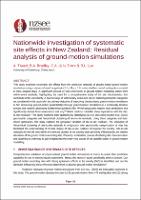| dc.contributor.author | Tiwari, Ayushi | |
| dc.contributor.author | Bradley, Brendon | |
| dc.contributor.author | de la Torre, Christopher | |
| dc.contributor.author | Lee, Robin | |
| dc.date.accessioned | 2024-07-01T02:01:08Z | |
| dc.date.available | 2024-07-01T02:01:08Z | |
| dc.date.issued | 2024-04-09 | |
| dc.identifier.uri | https://repo.nzsee.org.nz/xmlui/handle/nzsee/2680 | |
| dc.description.abstract | This study examines systematic site effects from the prediction residuals of physics-based ground motion simulations using a dataset of small magnitude (3.5 ≤ Mw ≤ 5.0) active shallow crustal earthquakes recorded in New Zealand (NZ). A significant amount of total uncertainty in ground-motion modelling comes from within-event residuals, highlighting the need for a comprehensive study of the site characteristics that contribute to this uncertainty. A diverse range of sedimentary basins and sites in distinct geomorphic categories are considered in this study with the primary objective of improving physics-based ground motion simulations in NZ. Advancing ground-motion predictability through ground motion simulations is a continually iterative process and requires addressing fundamental questions like: Which geographic regions have predictions that significantly deviate from observations and why? Which sites exhibit systematic prediction residuals and how can the attributes influencing them be identified? Which predictor variables show dependence with the site-to-site residuals? This study examines these questions by classifying 212 NZ sites using Nweke et al. (2022) geomorphic categories and hierarchical clustering of site-to-site residuals. Using these categories and data-driven approaches, this study explores the geospatial variation of site-to-site residuals. The utilization of hierarchical clustering of site-to-site residuals in conjunction with geomorphic categorization of sites has facilitated the understanding of diverse shapes of site-to-site residuals throughout the country. Presently, an iterative process of utilizing site characterization and clustering is underway to gain insights into the underlying causes of site-specific biases and inaccuracies in ground-motion modelling. | |
| dc.language.iso | en | |
| dc.publisher | New Zealand Society for Earthquake Engineering | |
| dc.relation.ispartofseries | 2024;54 | |
| dc.subject | Engineering seismology, including basin and site response, seismic hazard and risk | |
| dc.title | Nationwide investigation of systematic site effects in New Zealand: Residual analysis of physics-based ground motion simulations | |
| dc.type | Article | |

